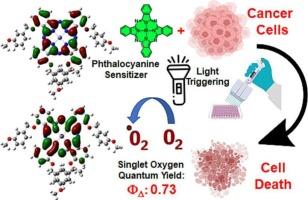潜在的基于酞菁锌的光敏剂用于光动力治疗:光物理,理论和体外研究
IF 3.2
2区 化学
Q2 BIOCHEMISTRY & MOLECULAR BIOLOGY
引用次数: 0
摘要
新型光敏剂的制备和光动力疗法(PDT)的研究为有效的医学治疗提供了有希望的结果和现实的期望。酞菁(Pcs)由于其分子的多功能性和优越的物理化学性质而变得非常有吸引力。基于这些事实,本研究采用含3-甲氧基苯氧基的邻苯二腈衍生物环四聚法制备了非外周取代锌(II) Pc(2)。并进行了理化和体外分析。在光化学研究中,得到的单线态氧量子产率(ΦΔ)值在二甲基亚砜(DMSO)中为0.73,在二甲基甲酰胺(DMF)中为0.55。基于密度泛函理论(DFT)的理论计算提供了有关电子激发的能量和特征的有价值的信息,从而可以预测它们在产生单线态氧方面的潜在适用性。采用体外结肠癌细胞系研究了含3-甲氧基苯氧基取代基的酞青锌(II)的PDT活性。在细胞毒性实验中,发现对细胞系最有效的孵育时间为24 h,最有效的浓度为8 μM。随着功率密度的增加,细胞存活率显著降低。结果表明,新合成的锌(II) Pc是一种有效的光敏剂,具有治疗结肠癌的潜在应用价值。本文章由计算机程序翻译,如有差异,请以英文原文为准。

Potential zinc phthalocyanine-based photosensitizer for photodynamic therapy: Photophysical, theoretical and in vitro studies
The preparation of new photosensitizers and studies on photodynamic therapy (PDT) have provided promising results and realistic expectations for an efficient medical treatment. Phthalocyanines (Pcs) have become extremely attractive for this purpose owing to their molecular versatility and superior physicochemical properties. Motivated by these facts, in this study, non-peripherally substituted zinc(II) Pc (2) was prepared by cyclotetramerization of the phthalonitrile derivative bearing 3-methoxybenzyloxy units. Also, physicochemical and in vitro analyses were completed. In photochemical studies, the obtained singlet oxygen quantum yield (ΦΔ) values were 0.73 in dimethylsulphoxide (DMSO) and 0.55 in dimethylformamide (DMF). Theoretical calculations based on density functional theory (DFT) provide valuable information on the energies and character of the electronic excitations, thus allowing a prediction of their potential applicability to generate singlet oxygen. The PDT activity of the zinc(II) phthalocyanine bearing 3-methoxybenzyloxy substituents was tested via in vitro studies using the human colon cancer cell lines. In cytotoxicity experiments, the most effective incubation time for cell lines was found to be 24 h, and the most effective concentration was 8 μM. Furthermore, the cell viability rate decreased significantly with the increasing power density. The results suggested that the newly synthesized zinc(II) Pc is an effective photosensitizer with potential use for the treatment of colon cancer.
求助全文
通过发布文献求助,成功后即可免费获取论文全文。
去求助
来源期刊

Journal of Inorganic Biochemistry
生物-生化与分子生物学
CiteScore
7.00
自引率
10.30%
发文量
336
审稿时长
41 days
期刊介绍:
The Journal of Inorganic Biochemistry is an established international forum for research in all aspects of Biological Inorganic Chemistry. Original papers of a high scientific level are published in the form of Articles (full length papers), Short Communications, Focused Reviews and Bioinorganic Methods. Topics include: the chemistry, structure and function of metalloenzymes; the interaction of inorganic ions and molecules with proteins and nucleic acids; the synthesis and properties of coordination complexes of biological interest including both structural and functional model systems; the function of metal- containing systems in the regulation of gene expression; the role of metals in medicine; the application of spectroscopic methods to determine the structure of metallobiomolecules; the preparation and characterization of metal-based biomaterials; and related systems. The emphasis of the Journal is on the structure and mechanism of action of metallobiomolecules.
 求助内容:
求助内容: 应助结果提醒方式:
应助结果提醒方式:


